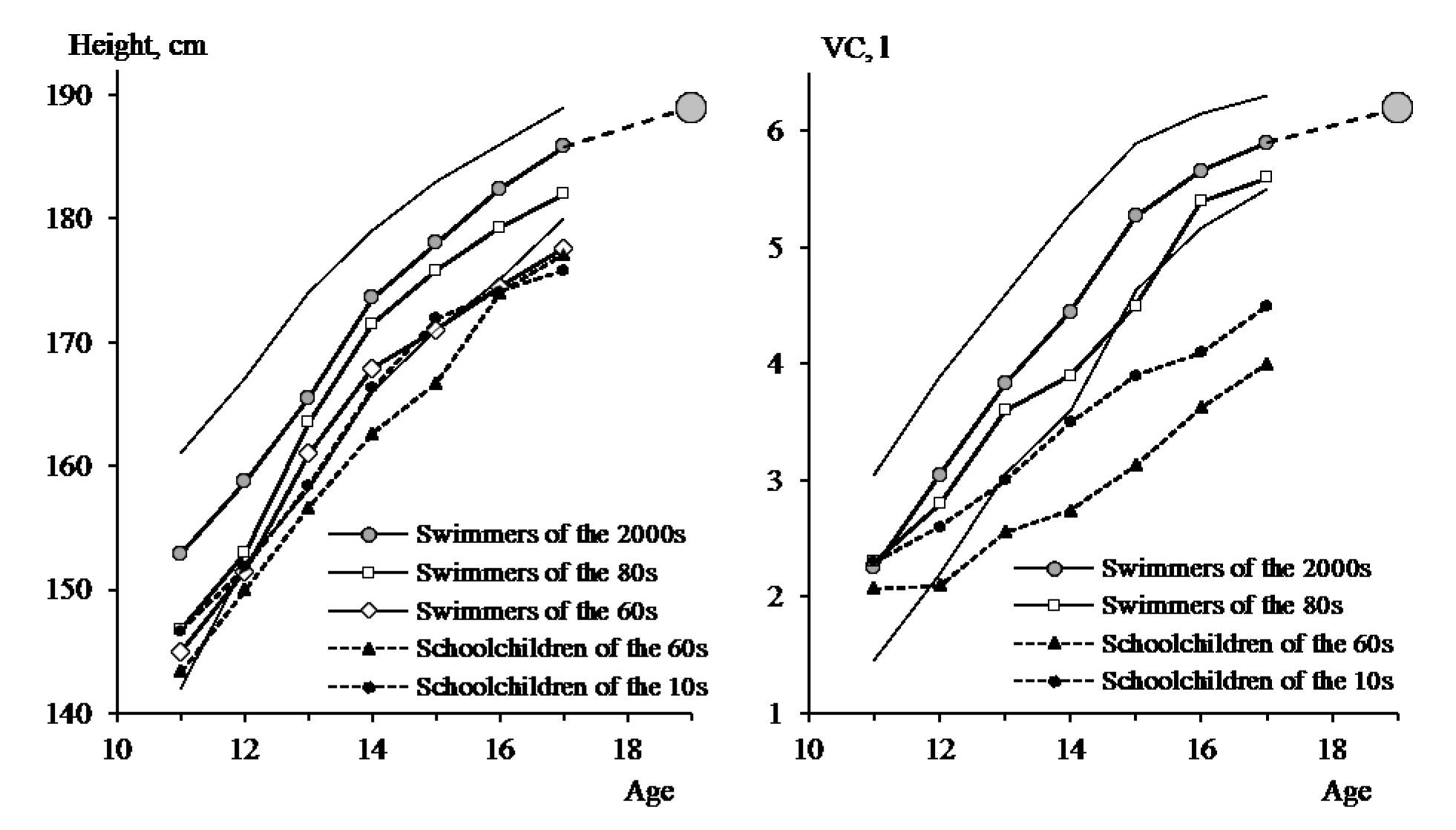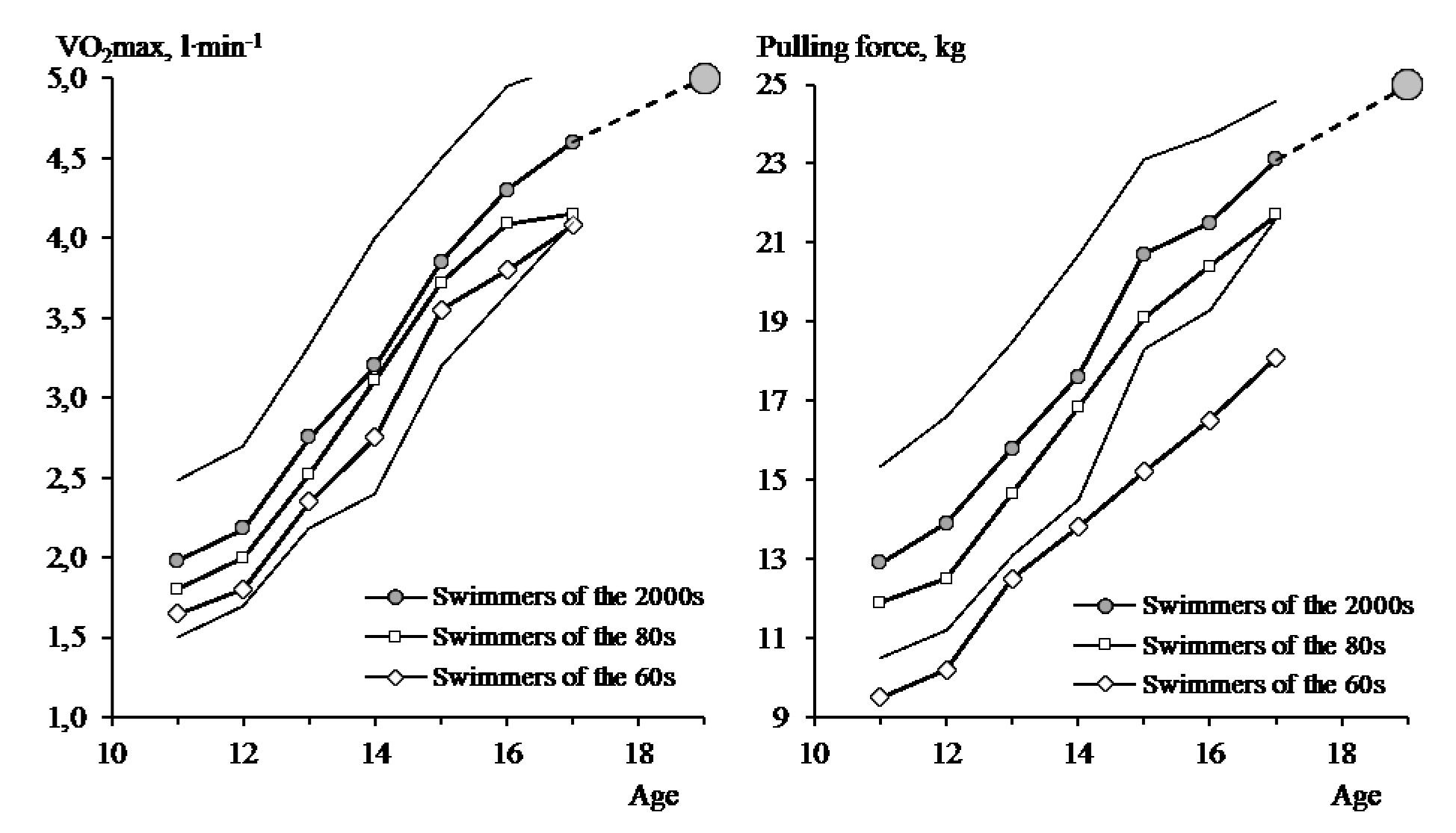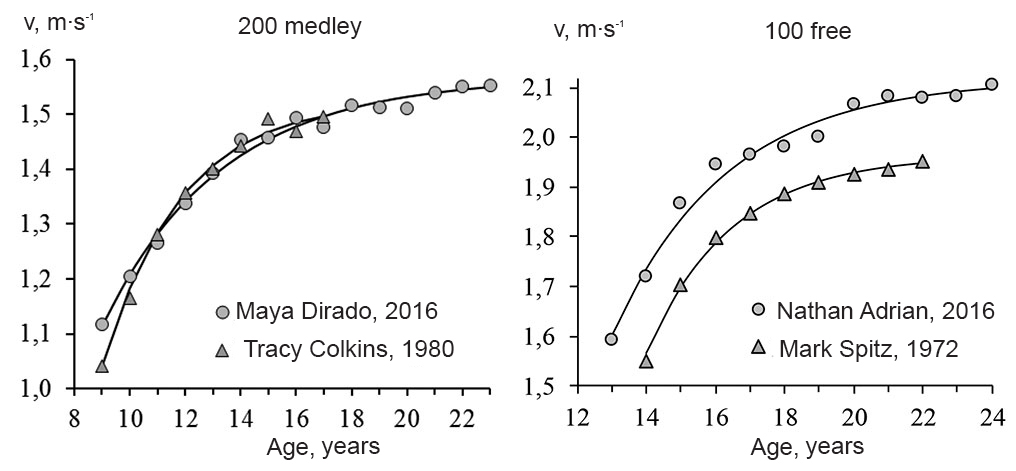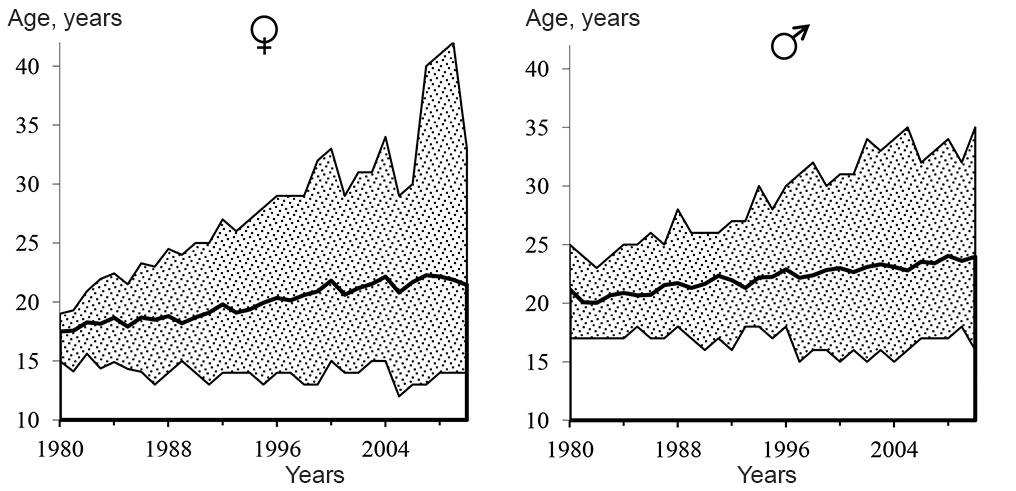Age-specific sport progress trajectories profiled by somatic and special working capacity rates versus competitive accomplishments in swimming sport
Фотографии:
ˑ:
Dr.Hab., Professor N.Zh. Bulgakova1
Dr.Hab., Professor O.I. Popov1
Postgraduate G.G. Ferreira2
Russian State University of Physical Education, Sport, Youth and Tourism (GTSOLIFK), Moscow
Fort Lauderdale, United States
Keywords: age-specific progress, somatic rates, special working capacity, age-specific competitive progress.
Introduction. The objective of the long-term athlete development model is to ensure the optimal development of physical abilities and functionalities, as well as, prepare a structure of specific athletic capabilities required to reach the maximum individual development in the ideal age for peak performance. The range of progress in physical abilities and functional systems is provided, on the one side, by talent and individual mechanisms of age-specific progress and, on the other side, by the quality of the training process [5, 13, 14].
The important goal of the long-term athlete development model in swimming is to determine the model characteristics, which influence swimming performance more than any other. The ultimate swimmer’s model would have combined all these model characteristics. In the sphere of the long-term athletic development, it becomes necessary to create coherent models for different ages and phases. The traditional approach to finding the model characteristics is based on the general evaluation of highly skilled swimmers followed by statistical work to verify the relation of the measurements with swimming performance. It turns out that many factors limiting success in competitions are weakly correlated with elite swimmers’ performance. A solution to this problem is offered in longitudinal research – “cross-sectional studies”, which investigate the dynamics of the model characteristics with age. One can build a multi-stage system of talent search and long-term training only by comparing age standards, evaluating the stability of each of the indicators and the possibility of compensating one possibly low indicator by improving others [2, 14].
Sports experience shows, that young champions often see a reduction in their improvement rate throughout the years. Besides that, it is frequently observed when athletes, who used to perform not so successfully, begin to step their performance and even overcome those “young champions”. Only 2% of the top 100 swimmers in the age of 10 and under in the USA find themselves in the top 100 in the open (all-ages combined) list [20]. This fact can commonly be explained by the intensification of training of young talents. They start to train with senior swimmers too early, being engaged in high intensity swimming training [9, 14]. But it is not recommended to wait too long for transferring to the word class athletes’ level otherwise the sensitive periods of development of the key physical abilities will be missed [2, 19, 21]. It is possible to establish the optimal trajectory for improvement of sportsmanship by analyzing the career of the world best swimmers (multi-year results dynamic, fitness indicators and physical development throughout the years).
Methods and research organization. In between 1962 and 2005, 1400 nation’s best junior swimmers had their physical development, special working capaсity and morpho-functional indicators evaluated.
The age-related performance curve can be described by the equation [2, 7, 10, 15]:
v = v0 + (vlim – v0)∙(1 – e–αT), (1)
Where v – swimming speed; v0 – swimming speed at the beginning of the career, m∙s-1; vlim – maximum speed, m/s; Т – years of swimming career; α – performance improvement indicator, year-1; е – base of natural logarithms. 31 athletic biographies were taken from the USA Swimming data base in total [18] and completed with surveys of the 2016 USA Olympic Team when necessary. The value of the season best speed and age were put in a diagram. The parameters of the equation (1) were determined by minimizing the sum of deviation squares in Excel sheets. The upward part of the trajectory - at the beginning of the career to the personal record of each swimmer - was included in the processing.
Results and discussion. The growing competition in sports and increasing training loads formed the elite swimmer’s morphotype, which varies depending on competitive distances and strokes [1, 4, 16, 17].
The height and vital capacity (VC) development dynamics of competitive swimmers is presented in figure 1. According to the data presented, an increasing tendency is observed in the height of swimmers of different ages. In the 2000’s, the 11-12 year age group athletes already show a significant gap compared with non-athletes of the same age. The highlighted area on the diagram is representing the average value, which is related to the model characteristics of elite swimmers.

Figure 1. Height and VC development dynamics in swimmers of different generations and age.
The data shown was obtained from the RSUPESYT Swimming Department archive [6] and students [8,12]. The shaded area corresponds to 1 and 7 points on a 7-point scale. The higher points correspond to the model value of the elite swimmers.
As seen on the diagram presented in Figure 1, the morphological indices’ growth rate slows down at the age of 17-18 years, indicating that the probability of reaching the model characteristic’s value is much higher at this age when the athlete’s development trajectory is close to the higher limit of the “model corridor”.
From the age of 13, current elite swimmers show higher VC rates than their peers from the past. The 90’s mean group value is close to the 80’s higher limit (which has a +2σ deviation). According to the data shown already in the 60’s, the swimmers had higher than average values for non-sporting students and this difference was only growing through the years.
It is important to note that two top-10 swimmers from the 60’s had comparable results to the 2000’s elite average when being between 6 to 8 years old before they reached their peak performance.
The development dynamics in stationary swimming is presented in Figure 2. Even though the current swimmers perform visibly better than previous generations, the differences in maximum oxygen consumption and pulling power are statistically insignificant in most of the cases. But it should be noticed that the future elite swimmers were on the higher than average level and were close to the higher limit +2σ.

Figure 2. Different generations’ age-related dynamics in the maximum oxygen consumption and pulling power test results
.The difference between generations in the pulling power test was more significant. Swimmers from the 60’s were close to the lower limit (-1.5 σ deviation). There are no doubts that swimmers with moderate pulling power rates are far from the model parameters. Even the stronger swimmers from the 60’s are below the group average in the following decades in this value.
Figure 3 contains the examples of results curve from Olympic champions Maia DiRado (200 Medley) and Nathan Adrian (100 Freestyle).

Figure 3. Age-related dynamics of results of Olympic champions 1972-2016. The line is an approximation of the exponential equation with a limiting value.
The results of Olympic Champions Mark Spitz (1972) and Tracy Caulkins (1980) are presented for comparison. As seen from the diagrams, the results trajectory of both past and current swimmers can be very well approximated by exponential dependence. The differences appear at the considerably longer period of their careers, exactly where the difference in results is found. In the 70’s and 80’s the swimmers stopped improving (or stopped participating in swimming competitions) by the age of 19-21 for men and 16-18 years old for women. Nowadays, the US Team best swimmers still show a strong improvement in results by the age of 22-24 and even older. Table 1 contains α values, which characterize the improvement rate of different generations. In the 80’s and 90’s the rates were considerably higher, especially in middle distance swimming. Additionally, the swimmers were getting close to their individual limit and reaching a plateau in performance quicker. As shown in the earlier generations, current male swimmers have α value higher than female ones, even though the differences are statistically insignificant.
Table 1. Rate of growth in results (α, year-1) of earlier and current generations of swimmers
|
Distance |
Swimmers of the 80’s and 90’s [9] |
USA Team – 2016 Olympics |
||
|
Women (n = 29) |
Men (n = 28) |
Women (n = 29) |
Men (n = 28) |
|
|
100 m |
0,377±0,072 |
0,344±0,109 |
0,258±0,076 |
0,197±0,072 |
|
200 m |
0,400±0,107 |
0,338±0,085 |
0,281±0,049 |
0,252±0,079 |
|
400 m |
0,565±0,077 |
0,353±0,148 |
0,305±0,058 |
0,283±0,085 |
The alpha values can be used to evaluate and set goals of the long-term training. The development corridor presented in the Youth Sport School Program [12] was designed using data of elite swimmers of the previous decade. It is used to make long term training programs and to evaluate individual improvement rates throughout the swimming career.
To a certain level this changing tendency in the career trajectory is supported by the analyses of the dynamics of average age of the top 10 swimmers of the world in between 1980-2010.

Figure 4. Dynamics in the world’s average age of the top 10 swimmers during the 1980-2010 period. The highlighted area represents the minimum and maximum values found.
The last data are from 2010, since FINA stopped indicating the age or date of birth in its rankings. Until the mid-80’s, the average age was 19-20 years old for men and 17-18 - for women. Later, the average started to vividly raise until it reached today’s values: 23-24 for men and 21-22 for women.
It is interesting to note, that the minimum age to enter the top 10 list remains almost the same for the past 40 years: 15-16 for men and 13-14 for women. The raise in the average comes from the raise in the maximum age, which broke the 30-year level during the mid-90’s. These values have a large variation from 30 to 36 years old and do not differ significantly between genders.
The raise in the swimmers’ career lifespan also increases the duration of the long-term training, particularly the duration of maximum individual performance phase. This data calls for improvement in the training organization at sport schools and Olympic Reserve schools.
Conclusions
1.The performance pattern throughout the swimmers’ career remains the same, however the performance improvement rates and age limits have changed.
2.The raise in the age average among the finalist in the biggest competitions in the world and the world top-10 ranking is related to the increased swimmer career’s lifespan. This fact comes to reject the hypothesis of a longer period of training in the teen years of a swimmer. This scenario is due to professionalization and bigger commercial possibilities of elite swimmers and slowdown in world record dynamics.
3.When determining the performance standards of the age-development curves for indicators that limit the level of achievement, it is inappropriate to focus on the mean values obtained during the “cross-sectional studies”, because prospective as well as unpromising athletes fall into the groups of surveyed swimmers. If we cannot rely on the dynamics of elite swimmers, the upper limits of deviations from the mean values should be oriented.
4.When evaluating how promising a swimmer’s career is one should verify not only absolute test values, but also how constant their improvement rates are. Especially stable high levels of improvement rates make the difference between average good young swimmers and outstanding future elite athletes.
References
- Bulgakova N.Zh., Popov O.I. Vozrastnaya dinamika i biologicheskaya zrelost pokazateley fizicheskogo razvitiya i spetsialnoy rabotosposobnosti, limitiruyuschikh skorost plavaniya [Age dynamics and biological maturity of physical development and special performance rates, limiting swimming speed]. Novye issledovaniya, 2009, no. 2 (19), P. 97.
- Bulgakova N.Zh., Popov O.I., Partyka L.I. Plavanie v XXI veke: prognozy i perspektivy [Swimming in the 21st century: forecasts and prospects]. Teoriya i praktika fiz. kultury, 2002, no. 4, pp. 29-34.
- Verkhoshanskiy Y.V. Ob optimalnom upravlenii protsessom stanovleniya sportivnogo masterstva [On optimal management of sportsmanship building process]. Teoriya i praktika fiz. kultury, 1969, no. 10, pp. 2-6.
- Vorontsov A.R. Periodizatsiya mnogoletney podgotovki yunykh plovtsov – programma dolgosrochnogo razvitiya yunykh sportsmenov [Periodization of long-term training of junior swimmers - program of long-term development of junior athletes]. Plavanie – III. Issledovaniya, trenirovka, gidroreabilitatsiya [Swimming - III. Research, training, hydrorehabilitation], St. Petersburg, 2005, pp. 194-207.
- Guberman Sh., Gordon S., Skvortsov Y. Prognozy rezultatov sorevnovaniy po plavaniyu [Forecasts of swimming competition results]. Sport za rubezhom, 1980, pp. 13-15.
- Kiseleva A.S. Gigienicheskoe obosnovanie otsenki fizicheskogo razvitiya gorodskikh shkolnikov v sisteme populyatsionnogo monitoringa. Dis. kand. med. nauk [Hygienic rationale for physical development rates of urban schoolchildren in population monitoring system. PhD. diss. abstract]. Nizhny Novgorod, 2014, 155 p.
- Platonov V., Bolshakova I. Forsirovanie mnogoletney podgotovki sportsmenov i Yunosheskie Olimpiyskie igry [Stimulating long-term training of athletes and Youth Olympics]. Nauka v olimpiyskom sporte, 2013, no. 2, pp. 37-42.
- Platonov V.N., Bulgakova N.Zh., Vorontsov A.R. Postroenie protsessa mnogoletnego sovershenstvovaniya. Glava 28 [Building longterm improvement process. Chapter 28]. Sportivnoe plavanie: put k uspekhu: v dvukh kn. [Sports swimming: way to success: in 2 books]. Moscow: Sovetskiy sport publ., 2012. Kn. 2, pp. 197-252.
- Popov O.I. Zakonomernosti dinamiki sportivnykh rezultatov elitnykh plovtsov na etapakh mnogoletney podgotovki [Regularities of dynamics of sports results of elite swimmers at different long-term training stages]. Sbornik trudov uchenykh RGAFK [Collected Works of RSAPC Scientists]. Moscow: Fizkultura, obrazovanie, nauka publ., 2000, pp. 63-67.
- Avlonitou E. Somatometric variables for preadolescent swimmers. J Sports Med and Phys Fitness, 1994. Vol. 34, no. 2, pp.185-191.
- Carter L., Ackland T. Kinanthropometry in aquatic sports: A study of world class athletes. Champaign: Human Kinetic, 1994 (Sport science monograph series, Vol. 5).
- Individual Times Search. USA Swimming. Available at: http://www.usaswimming.org
- Lang M., Light R. Interpreting and Implementing the Long Term Athlete Development Model: English Swimming Coaches’ Views on the (Swimming) LTAD in Practice. International Journal of Sports Science & Coaching, 2010, vol. 5, no. 3, pp. 389-424.
- Sokolovas G. Participation of elite swimmers: From USA swimming’s all-time top 100 times. Coaches Quarterly, 2002, vol. 8, pp. 1-5.
Corresponding author: fizkult@teoriya.ru
Abstract
Objective of the study was to analyze the age-specific sport progress trajectory design models with the progress profiled by the relevant performance, fitness and physicality test rates versus the competitive accomplishments in modern swimming. Subject to the study were the nation-strongest 11-17 year-old male swimmers (n=1400 plus) for the period of 1962 to 2010, with variations of their core physical fitness and functionality rates (including strength rates) being subject to a special analysis. The anthropometrical data of the sample were obtained by the commonly accepted methods, and the age-specific progress rates of the swimmers were mined in the FINA (International Swimming Sport Federation) records of the world-strongest swimmers. An exponential equation was used to approximate the years-long variations in the swimmers’ performance/ progress rates and accomplishments. The key findings of the study are as follows: as verified by the success histories of the elite swimmers, the age-specific competitive progress rates have notably changed for the last few decades. The growing ages of the finalists in the top-ranking international events and the top-ten world-strongest swimmers shall be interpreted as the recent progress in the sport longevity rather than a longer training period required to train an elite swimmer.



